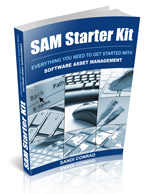Why Do I Need a Formal ITAM Practice?
 This article has been contributed by Sandi Conrad of Conrad & Associates.
This article has been contributed by Sandi Conrad of Conrad & Associates.
Sandi is the author of the “SAM Starter Kit” published by The ITAM Review.
Formalizing an ITAM practice to include a repeatable, auditing process is on most CIO’s lists of things to do. Unfortunately it’s often at the bottom of the list. Other technology projects take priority as they will help a business unit become more efficient, allow sharing or harvesting of information, or prevent a company from running into a disaster non-recovery nightmare. These projects are all important. However, the question that needs to be asked is why isn’t ITAM higher on the priority list?
We all know that there are only so many hours in a workday, only so many hands and minds available on the IT team, and only so much time available for purchasing or legal to deal with licensing matters. IT is often juggling multiple projects, so where is the incentive to add one more to the list? Especially one that no other business unit cares about? Or one that gets in the way of those other business units getting what they need?…right now?
From a budgeting and contract negotiation perspective, knowledge is power. If you know what contracts are due when, what purchases will need to be made throughout the year, what kind of support will be required and how many licenses are actually in use at any given time; you will be in a much stronger position to negotiate prices and specific terms required to customize a contract for your organization’s benefit.
If a software publisher or software watchdog group calls up looking for information, having it immediately available can prevent time consuming and costly audits. A medium sized organization (250-1000 PCs) without accurate records can expect a disruption of anywhere from 3 weeks to 6 months to respond appropriately to an audit request. Suddenly the priority is high to avoid litigation and the extra expense of an external auditor, which can significantly throw off other projects previously labelled as high priority.
Effectively managing lease returns and redeployed hardware and software also becomes much more challenging when a formal ITAM process isn’t in place. The costs of not returning hardware on time and of over purchasing hardware and software can become much higher than the cost of assigning a dedicated asset manager.
A few years ago, I worked with a large enterprise that had been buying software for each new employee based on a standard configuration. However, because they hadn’t worked through the entire asset management process, they didn’t realize they were not redeploying all of the assets. By guiding them through the asset management lifecycle and formalizing the process, we discovered the company was spending an extra $300,000 per year on extraneous software licenses. Creating a business case for ITAM was pretty easy after that.
 This article has been contributed by Sandi Conrad of Conrad & Associates. Sandi is the author of the “SAM Starter Kit” published by The ITAM Review.
This article has been contributed by Sandi Conrad of Conrad & Associates. Sandi is the author of the “SAM Starter Kit” published by The ITAM Review.
Sandi has been in the software business since 1991 and was one of the first Software Contract Administrators in Canada.
She has been providing consulting services since 1996, helping hundreds of clients to understand their obligations and rights under a myriad of contracts, and comparing licensing programs to find the most advantageous options for her clients.
~
Related articles:
Event Listing: itSMF SAM Masterclass 17th June
Big Data and IT Asset Management: A marriage made in heaven or hell?
Podcast Episode 38: ITAM Beyond the IT Department
ITAM in the Cloud Era: More questions than answers?
Defining Roles for ITAM in a Midsize Company
Wisdom UK 2019: A recap on our latest ITAM event
- Tags: ITAM · SAM · Sandi Conrad
About Martin Thompson
Martin is also the founder of ITAM Forum, a not-for-profit trade body for the ITAM industry created to raise the profile of the profession and bring an organisational certification to market. On a voluntary basis Martin is a contributor to ISO WG21 which develops the ITAM International Standard ISO/IEC 19770.
He is also the author of the book "Practical ITAM - The essential guide for IT Asset Managers", a book that describes how to get started and make a difference in the field of IT Asset Management. In addition, Martin developed the PITAM training course and certification.
Prior to founding the ITAM Review in 2008 Martin worked for Centennial Software (Ivanti), Silicon Graphics, CA Technologies and Computer 2000 (Tech Data).
When not working, Martin likes to Ski, Hike, Motorbike and spend time with his young family.
Connect with Martin on LinkedIn.
